A Ghost Of A Horrific Christmas Past
Saturday, January 10, 2009
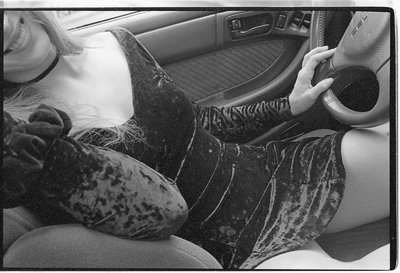
It was Christmas Eve in the morning some four or five years ago. I was having a pleasant coffee with my friend Ian across from the Exposure Gallery on Beatty Street. My cellular phone rang. It was S.... I had not heard from her for a couple of years. I had taken her pictures on and off for about three. She sounded just fine. "T... wants to talk to you." I did not know who this T... was. As soon as he began to talk to me I was never able to talk back or have him acknowledge what I said to him. He was brutal. He said, "I want you to return all the negatives that you took of S.... or I will hurt you terribly. I know where you live and I know where your daughters live. I am going to hurt them unless you return the negatives. People like you should not be allowed to live and should not have been born. The pictures that you took of S.... are disgusting and dirty. You are a monster. You should be dead."
I hung up.
"Never hang up on me again, or it will be worse. I will burn your house down."
I hung up.
I called Rosemary who told me that S.... had called and that she had wanted my cell phone number.
I called the police. A young policeman showed up within the hour. He told me that I had nothing to worry and that nothing was going to happen. These were only empty threats. " In most of these cases, they don't amount to much," he calmly added. I did not feel calmed. He gave me his card. " Call me if T... calls again.
Rosemary phoned all in an uproar. It seems some guy had called her and threatened her unless she convinced me to return stuff that belonged to him. I went right home. As soon as I was in the door the phone rang. I had a feeling it was T... It was T.... I was not able to stop his one-sided conversation which was all the worse because he almost whispered and never shouted. All he wanted form me was a, " Yes, I will return them." I was really scared for my life and I wondered if my decision to never give anybody my negatives unless they were purchased was a decision I would have to modify here. Should I sacrifice the health of my wife and daughters to defend my right to what was mine?

I called S....'s ex boyfriend who made it all worse. "That's T... the Taliban. He is a punk. He has S... really under house arrest and she cannot see any of her friends or get out of the house. If you like you and Rosemary and your daughters can spend a month with me in my house. You will be safe with me." That really made it worse even though I knew that the RCMP kept a watch on his house for some other stuff that has no bearing to this story.
T... called again and I was paranoid. I would look out of the window every time I heard a car. I would watch from the corner of the window.

Then I called my friend the hood. I told the hood everything. The hood said, " Alex, don't you worry. I can take care of this. That T... the Taliban is just a young punk. He doesn't know any better."
The cop called again for more names. I gave them out to him and he said he was going to investigate. He told me that every time that T... called I was supposed to press some key on my phone so that they could trace the call.
That Christmas Eve and the corresponding Christmas day were the worst of my life. Rosemary kept looking at me and saying just with her eyes, "Is it worth going through all this just for the sake of your pride and for some negatives of a girl who should have known better? " I was at the point of giving in.
Then T... never called again. The cop made an appointment to see me. He said, " Mr. Hayward, you have powerful friends. As far as I can tell you no longer have a problem." And he wouldn't tell me more. I called my friend Steven Pranzl a homicide cop who only told me just a bit more. He knew who my friend the hood was and added, " T... will not call you again."
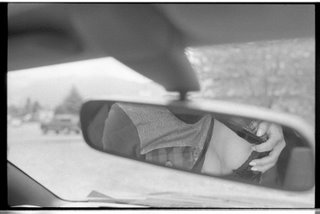
A year or two later I found out that S.... had gone to the police to obtain a restraining order on T... and she eventually married a nice man. As far as I know she is living happily ever after.
An Intimate Conspiracy & A Sweet Tooth
Friday, January 09, 2009
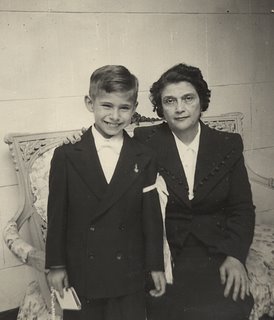 My grandmother Lolita had a sweet tooth. There is one time that is still vivid in my mind. I must have been around 14 and we were at the breakfast table. She was served a large cup of coffee in which she poured Carnation evaporated milk and a generous amount of sugar. She then buttered her bolillo, spread peanut butter on top and then spooned a thick portion of strawberry jam as if it were the most expensive caviar on it all. She looked at me with delight, winked and then dunked her creation into the coffee. I will never forget the clicking of her false teeth when she bit into her food. We had a conspiracy between us. Anything was allowable and or excusable because we were artistic. My mother and my father were the disciplinarians but if my grandmother was around I was always safe. She would say, "He did nothing wrong. He is an artist. He has inherited that from me and you need to understand that." Because of my abuelita I was dispatched to painting lessons with Robin Bond in Mexico City. Bond had honed his skills during the London Blitz as an expert in the art of camouflage. In Mexico City he was the only one who knew how to paint TV sets in the right shades of gray in the primitive era of b+w television. He was an old-style bohemian who smoked lots, drank large quantities of espresso laced with amber liquids from mysterious bottles. He mixed the paints for his canvases on his studio walls. It was at Bond's where I found out that artists liked lots of women. There were always many there. He had a studio couch with rumpled sheets. Perhaps his women posed for him there or perhaps not. I wondered. With my abuelita I discovered the wonders of Technicolor movies. They always featured handsome swordfigthers or weathered men like Randolph Scott. I learned about opera from her. "I was a coloratura soprano but my father did not allow me to become a professional. He said only harlots did that sort of thing." The word harlot was always the softer euphemism "mala mujer" or bad woman. She would then break into an aria from Donizetti's Lucia di Lammermoor. I cannot remember on single incident in which my grandmother ever told me I could not do something. It was always, "If you do this, this is what is going to happen to you." My favourite reaction from her when I would refuse to eat something I didn't like was (she said it in Spanish), "The donkey that got used to not eating died." But then she knew I knew of her own trick for not eating what she did not like, "I just love Brussels sprouts but they are so bad for my liver. If I were to eat them I would have a tremendous attack." Invariably she would look at me from the side and I knew the wink was coming. Until one day in the late 60s when Abuelita returned from Cairo and she looked at me an did not recognize me we had a special relationship. One particular incident is memorable. We went to the opening of a young Filipino painter and the pride of his show was a very large painting featuring a pair of ugly Mexican huaraches. "Tell me," she asked the young man, "why is it that you would paint something so ugly when there are so many beautiful things you could have painted?" The painter retorted very quickly to the delight of my grandmother, "Ah, but there is the beauty of ugliness!" Suddenly the three of us were onto something.  For a while I had hoped to reverse this role and relive it with my granddaughter Rebecca but it seems that the "conspiracy" between us is on hold and the distractions inch her away, day by day. Perhaps the longer days of late spring and the scent of my roses will bring her back.
Thursday, January 08, 2009
 The alumni of St. Edward's High School in Austin, Texas (from 1925 until 1975 the last year when the school closed but the adjacent St. Edward's University continued to the present day) is gearing up for a mass reunion (those of us who are alive and willing) in June. For more info on this for any Edwardian Tiger that might lurk in this blog click here. I have written at length and several times on my good years at the school. And in particular I have written of my teachers who with a few exceptions were Brothers of the Congregation of the Holy Cross. I have written about them here, here and here. But today I will write about a man who was not a Brother of the Holy Cross. Forrest Wright taught us civics, English and was the baseball coach of our team that won many state championships under his leadership. He was mostly a serious man. He had very red hair and when he got angry his face would turn the same colour. He was a perfectionist. He had a penchant for slacks with crisp, just-ironed creases and black cordovan leather shoes. I was just a tad afraid of him. There is no doubt that I respected him as much as I have any other man that earned my respect. 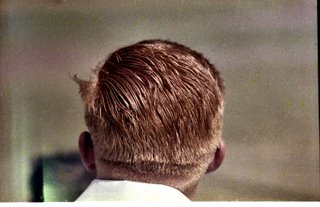 In these pages I have written about being an Argentine, Mexican, Canadian, and an American. I have even written about feeling much like a Texan. Of late as I read about Obama (Rosemary and I were always glued on election night and on the debates) I feel very American. I have been reminiscing a lot of my four years in Texas.  Today I looked into my 1961 (my graduating year) Edwardian year book. The year book (our class yearbook, my yearbook) is dedicated to President John F. Kennedy. The dedication reads: The students of Saint Edward's High School are proud to make their Edwardian dedication to the First Man of the Land; to one who has been brought up in the same traditions of Democracy as they; to one who has made real and concrete faith in the American ideal that equality of person is the basis for American Democracy; to one who has won his office through public "trial" on the most important issues which have ever faced the Commander-in-Chief of our country; to one who has the fire of the Founding Father, the knowledge of things present based on things past, the enthusiasm and vigor of the young-in-heart, the determination of a man who must prove himself, the faith, the humility and charity of a Christian -- the President of the United States, John F. Kennedy.
The Students of Saint Edward's High SchoolI must not have given much thought to that page and the contents in 1961 but today as I write this I am moved by the dedication and a realization that I still feel that Kennedy was my president simply because I was an American. Perhaps it has all to do with Forrest Wright. He taught me English and he taught me to write. But he also taught me civics. Some of his classes introduced us to such mundane differences that exist between a misdemeanor and a felony with the subsequent months or years of incarceration that each came with. He taught us the difference between first and second degree murder and all about habeas corpus. Wright taught us about the American Constitution and how politics in the US worked with caucuses and primaries. I remember how he gesticulated with the thumb and index finger of his right hand to make a point. In combination with Brother Francis's class of American history I learned quite a lot (and well) about the United States. Both men taught me pride in the concept of democracy and our ability to put faith in the system. 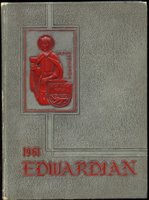 Forty seven years later with the nearness of Barack Obama's inauguration I find that I don't seem to feel less proud, less hopeful or less American even though I am really an Argentine with a love for Mexico, Texas and Canada.
Suna no Onna
Wednesday, January 07, 2009
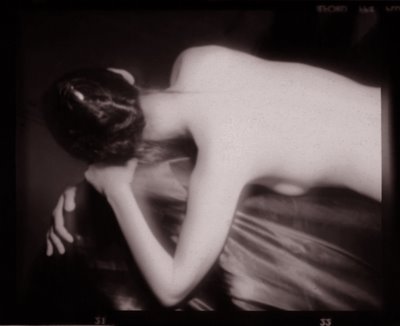
In 1965 in Buenos Aires I went with Susy to see a film I will never forget. I saw it once. Susy was out to educate me and mold me to her desire that I be cultured. She took me to see my first two operas at the Teatro Colón, Sergei Prokofiev's Fiery Angel and Christoph Willibald Gluck's Orfeo ed Uridice. She especially wanted to break my love for westerns and war films. She said I was uncouth. She wanted me to appreciate European art films. My previous experience had not been a good one. I had seen most of Michelangelo Antonioni films because I had the hots for Monica Viti not because I understood the Italian cinematographer's art.
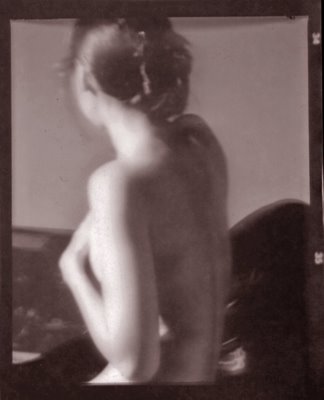
The film I saw with Susy was Hiroshi Teshigahara's 1964 The Woman in the Dunes or Suna no Onna. It was a beautifully startling film. It was as erotic as film as I have ever seen. This film has remained fused in my memory like a bad sunburn at the beach at the end of a hot summer day. No matter where I have gone since, I look at sand in a way I had never done before. I had never seen a film where you could hear (or was it my imagination?) the falling of individual grains of sand.
Sand: An aggregate of rock fragments. Sometimes Including loadstone, tinstone, and more rarely gold dust. Diameter: 2 to 1/16 mm.
The Woman In The Dunes - Kobo Abé

In The Woman in the Dunes the woman was the sexual agressor. It didn't quite hit me then how unlikely this was coming from a then very conservative and male-oriented Japanese society.
He started toward the container on the earthen floor for a little water. Suddenly he heard the breathing of the sleeping woman on the other side of the sunken hearth and looked over. He swallowed his breath, quite forgetting the aching of his eyelids. She was stark naked.
 She seemed to float like a blurred shadow before his tear filled eyes. She lay face up on the matting, her whole body, except her head, exposed to view; she had placed her left hand lightly over her lower abdomen, which was smooth and full. The parts that one usually covered were completely bare, while the face, which anybody would show, was concealed under a towel. No doubt the towel was to protect her nose, mouth and eyes from the sand, but the contrast seemed to make the naked body stand out even more.
She seemed to float like a blurred shadow before his tear filled eyes. She lay face up on the matting, her whole body, except her head, exposed to view; she had placed her left hand lightly over her lower abdomen, which was smooth and full. The parts that one usually covered were completely bare, while the face, which anybody would show, was concealed under a towel. No doubt the towel was to protect her nose, mouth and eyes from the sand, but the contrast seemed to make the naked body stand out even more.
The Woman In The Dunes - Kobo Abé
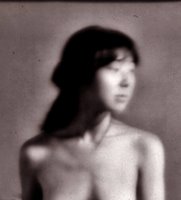
In this film sand pours and is in everything. Watching the protagonists drink made me want to drink. I could feel the grit of the sand that was present in everything, in their food, in their drink, in their eyes, in their cavities.
She gathered up the towel with a nervous gesture, and with unexpected energy slapped her face with it two or three times and then, completely turning her back to him, crouched with her knees doubled beneath her and her face to the floor. Was it a bashful movement? This was hardly the place. The man let out a shout as if a dam had given way.
The Woman In The Dunes - Kobo Abé

Halfway through he film I could guess what the man, amateur entomologist Nikei Jumpei already knew. He was in a sandpit with a woman and he would never be able to escape- a Sisyphus, eternally at the bottom of a hole. No great stone to push up just grains with little variations that follow a Gaussian distribution curve with a true mean of 1/8mm.
Then there was a small avalanche of sand.
Apprehensively, he returned to the hut. He went directly to the woman, who had remained crouching. He raised his left hand threateningly. His eyes glittered as he stood there agonizing. But halfway through the gesture, his arm, which he had raised with such purpose, suddenly collapsed. Perhaps he would feel better if he slapped the naked woman. But wouldn't this be just the part he was expected to play? She was waiting for it. Punishment inflicted, in other words, would mean that the crime had been paid for.
The Woman In The Dunes - Kobo Abé

For several years I photographed Helen Yagi. The pictures here I took with my Mamiya RB modified to be a pinhole camera. Looking back I can understand now that Helen was the best subject I ever had and that any limitations that I may have felt in taking her photographs were my own personal limitations. When she found out about my love for the film The Woman in The Dunes she said, "Alex why don't we bring bucketfulls of sand up to your studio and shoot scenes from the film?" I thought, at the time that Helen was crazy. How were we going to cart all that sand up three floors and then get rid of it? Of course she was not crazy at all. I simply could not see. Just like Nikei Jumpei, I had no vision at the bottom of my sandpit.
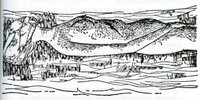
A few days ago while browsing through the fiction section at Chapters I found Kobo Abé's The Woman in the Dunes translated by E. Dale Saunders and illustrated by Machi Abé. It is a Vintage International edition, 1991.
more
One Wise King - Not
Tuesday, January 06, 2009
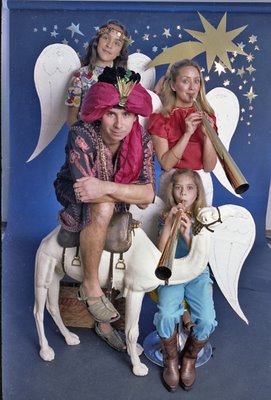
At least twice by the end of 2008 I wrote about melancholy, here and here. While much of that melancholy was dissipated by Christmas cheer it is back in full force as I contemplate on my Christmas tree on January 6, the Epiphany or as we know it in Latin America Los Tres Reyes Magos. I wrote about my personal relevance to the Epiphany here.
Even though I was 11 years old at my last Argentine Tres Reyes, the lazy and hot summer days and my being sent to some remote "camp" (as Anglo Argentines call the campo or pampa) , a place with a smooth, uninterrupted horizon and being forced (a good thing even though I was not aware then) to learn to make friends with people I had never met before.
The melting snow outside cannot cool the feeling of warmth and nostalgia that I have for the Epiphany and the terrible (then) gifts of useless wooden toys that Eva Perón gave us on that day when all I wanted was an Erector set or an electric train.
Part of the allure is in the Spanish meaning of mago. A mago in Spanish is a magician. The three wise kings, los tres reyes magos, were magicians to us. All was possible if they intervened. I thought then that the little box of myrrh probably also contained a pristine white rabbit ready to jump out and delight the precocious newborn in that stable crib.
And of course that melancholy is further increased by having to remove the ornaments from the tree which we traditionally perform tomorrow. It's been up for what seems only a few days. But the tree has become my friend. Every time I come into the living room to write my blog I can smell with delight the scent of my Pseudotsuga menziesii or Douglas Fir.
But some of that melancholy has vanished as I found this picture which was our Christmas card for 1981. I took the picture in our Burnaby basement in November 1981 so Hilary (below, right) was 9 and Ale was 13. Our basement had a very low ceiling so I was forced to use a wide angle lens which made people in front look bigger than those in the back. That the whole family was present for Christmas Eve dinner 27 years later has to be something that even makes this melancholy man smile, if only for a short while.
Las Hermanas En Los Vestiditos Negros
Monday, January 05, 2009
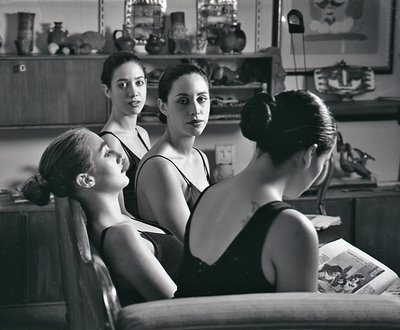
I faced these four lovely sisters only once and I barely rose to the occasion with these snapshots. Since then I regret not having put more effort into the opportunity. I have discovered a beautiful essay on the little black dress in a blog from Oviedo Spain (sadly now gone). It is in Spanish, alas! One expression caught my eye, El Ford de Chanel which is all on how Ford's Model T came only in basic black. Any essay on the little black dress that mentions Tippi Hedren, Kim Novak and Grace Kelly already has something going for it!
Two of the young girls are my friend Nora Patrich's daughters the other two are Linda Lorenzo and her sister. Nora kept talking about some obscure tango which cited the names of four girls.
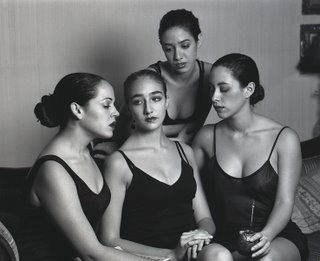
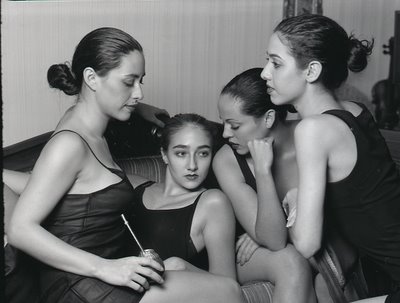
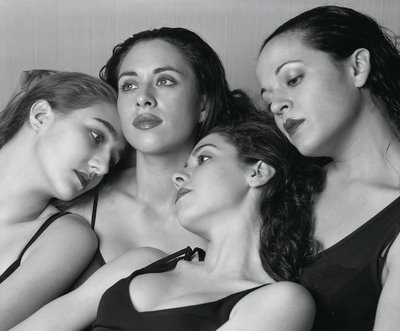
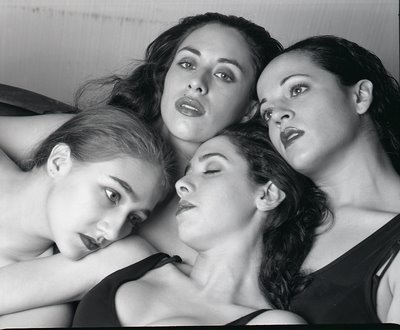
Billiken, Potential Energy & Kanfer's Brando
Sunday, January 04, 2009
 This is publisher Faber & Faber's short biography of writer Stefan Kanfer: Stefan Kanfer
Stefan Kanfer’s books include The Eighth Sin, A Summer World, The Last Empire, Serious Business, Groucho, Ball of Fire and Stardust Lost. He was a writer and editor at Time for more than twenty years and was their first bylined film critic, a post he held from 1967 until 1972. A Literary Lion of the New York Public Library and recipient of numerous writing awards, Kanfer is currently in the Distinguished Writer Program at Southampton College, Long Island University. He divides his time between New York and Cape Cod. There are numerous reviews of Kanfer's latest book, a biography of Marlon Brando called Somebody - The Reckless Life and Remarkable Career of Marlon Brando.I will probably buy it as I have been very close to Stefan Kanfer even though I have never met him nor communicated with him. It was around 1964 that I discovered Time Magazine. I was young and not cynical. I had yet to hear, "Life Magazine for the people who cannot read - Time Magazine for the people who cannot read." I did not yet know on how newspapers and magazines could bend the truth. I had been a little boy around 8 when I had some doubts about the existence of Santa Claus. When I saw a picture of St Nicholas Bishop of Myra in the Argentine children's magazine Billiken saying he was Santa Claus my doubts about his existence were erased. If Billiken said he existed he must exist. While in Argentina in the middle 60s I made it a point to read Time every week. Every once in a while I would not be able to find it. This usually happened when some Argentine general did not like what Time had said about the military government. It was around 1965 that I remember sitting in a park bench of the Buenos Aires zoo that I read a wonderful film review. It was credited to a Stefan Kanfer. I soon found myself being able to identify the man's style in the first sentence of any paragraph of any essay Kanfer wrote. It was with Kanfer that I first discovered that there was such a thing as literary style. Through the years I have discovered the inimitable Jerome Charyn in English and José Saramago in Spanish translated from the Portuguese. I love reading Maureen Dowd in the NY Times as she shares a stylistic flair with Charyn. While reading the review of Kanfer's new book on Marlon Brando in today's NY Times I spotted this: On the night "A Streetcar Named Desire" opened on Broadway, Tennessee Williams sent his young leading man a rapturous telegram: "From the greasy Polack you will someday arrive at the gloomy Dane for you have something that makes the theater a world of great possibilities."Looking back at that statement, Brando's line in On The Waterfront as Terry the washed up boxer: You don't understand. I coulda had class. I coulda been a contender. I coulda been somebody, instead of a bum, which is what I am, let's face it. It was you, Charleyhas a special resonance as Brando's path towards Shakespeare never went past his role as Marc Anthony. All that brings me to the theme of today's latish blog (a difference of opinion with my web server, Net Nation made them pull the plug for almost a day) which is all about the strange and wonderful topic of potential energy. A block of wood sitting without movement on a table has the potential of moving should a rapid wind suddenly come on the scene. Or it could be something as simple as tilting the table and then the block would be freed of some of the friction and gravity and perhaps slide downward a bit. Or magic could suddenly remove the table and gravitational pull would make the block fall. There is even energy stored in the block of wood in the form of the heat it could provide if we were to throw it into a small fire. Kinetic energy is physics’ way of defining the potential of everything that surrounds us and even ourselves. I think of potential energy when I think of my mother receiving a scholarship to study in the medical school of Johns Hopkins and not being able to take advantage because even though she had been born in Manila under American occupation she was deemed an alien Asian and barred from entering the US as a student. I think of my own potential as an engineer had I figured out the difference between capacitance and inductance before failing electricity. Somehow because of not being able to go to Johns Hopkins my mother went to Argentina and married my father and I am here writing this. I almost despair at the fact that my Rebecca was offered a full scholarship to attend a very good dance school but her parents turned it down. They don't want Rebecca to be a ballerina or a dancer. What potential is in this little 11 year old girl? Will I be around to see it realized? I don't know except to note that potential energy, potential human energy, keeps our dreams alive and our will to live.
|































